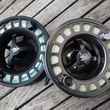In the time it takes our planet to complete an orbit around its sun, my friend Mike Sepelak goes fishing at least fifty-two times. More often if possible, but he’s set the bar at an average of once a week. I met Mike through his writing on a blog called Mike’s Gone Fishin’ Again, and, with a title like that, my only surprise about the frequency of his fishing was that he didn’t fish more.
Because I was spending the academic year on sabbatical in North Carolina, I contacted Mike, and he generously invited me on a few of his outings. Many of his trips are well-planned and researched, but his goal-securing outing for that year sprung from a simple invitation.
“I’m feeling itchy. Perhaps a quick trip early next week?”
“Please, and thank you,”’ I replied.
With seven days in a week, fishing fifty-two times a year should be easy. But it's not. We fritter away hours, squander days, and unwittingly populate our past with fishless week after fishless week. Father Time is a heartless scoundrel who steals with impunity, and we carelessly neglect to lock our doors. For those of us residing above the 45th parallel, the situation intensifies when our rivers vanish below an impenetrable floor of ice and snow for months at a time. And if we get little solace from chugging shots of Red Bull and Jagermeister while dangling a frozen line through an eight-inch hole in the ice, then we're left with two options to cope with the endless winter. Brood and pout, or migrate south for the season.
After brooding and pouting for over twenty years, my migratory home for the winter was about eleven degrees of latitude below—and over thirty degrees of temperature above—my usual residence. So when Mike and I met the morning of our trip to the river, I wore a thin fleece jacket and a thick wide smile. Mike wore the same. He said we'd drive for two hours, fish for six or seven, and then drive home. I had fished only once in roughly three months, so I hoped to devour those six or seven hours and leave little for Father Time to nab.
We parked in a small clearing near the river, where two overweight Labrador retrievers promptly greeted us. The dogs knew Mike from his many previous trips, so they enthusiastically volunteered to accompany us for the next four or five hours, presenting their watchful eyes and intimidating snarls as safeguards from the wild creatures that prowled the woods. In return for their services, they asked only that we occasionally pat their heads and speak a few comforting words in their general direction.
When we arrived at the river, Mike put me on a fishy-looking pool and waded downstream to swing streamers through a swiftly flowing run.
“Any advice on what I should do?” I asked.
“Fish for trout,” Mike said.
I knew little about this river, only that it was a tailwater, and the fish would likely feed on tiny midges. So, naturally, my first fish came on a size 18 bead-head pheasant tail, a fly I used only to get the trailing size 20 midge down to the trout. Another reminder that if and when I select the right fly, the trout—and only the trout—will let me know. I released the fish and snuck a glance at my watch. It was noon. Father Time had already seized a couple of hours; if I didn’t turn up my game, that merciless bandit would undoubtedly steal more from this glorious December day.
I fished steadily for another hour, then noticed Mike strolling along the bank behind me on his way upstream.
“Without looking at your watch, what time do you think it is?” I asked.
Mike glanced toward the sky. “I’d say it’s noon.”
“One o’clock,” I sighed.
“That’s later than I thought. We better keep casting.”
Mike waded into some faster water and motioned for me to follow. A little later, he spotted a pod of rising trout in a foamy eddy along the far bank and guided me into a perfect position across from the fish. I asked for advice, and he again suggested I “fish for trout.”
Most of the fish I'd seen that day were between eight and ten inches, and I had no reason to believe these were different. Regardless of the size of the fish, the margin for error with a size 20 or smaller dry fly is slight. In my probability class, I teach my students that if you toss a coin enough times, you can eventually see eight, ten, fifteen, twenty, or more successive tosses showing tails. You only need to be patient and persistent. And so it is with tiny flies and me. If I cast with purpose and care, the improbable sometimes transpires.
“Damn, it’s dragging again,” I blurted as the tiny fly seemed to skate near the end of its drift. Just then, though, the fly disappeared beneath a voracious rise, and the fish bolted for deeper water. “Or drifting perfectly,” Mike suggested as he snapped his net from its magnetic clasp.
After releasing the trout, I realized Mike had netted a fish for me on only our second outing. Was it too soon? Was our relationship ready for such intimacy? We did have much in common. We used the same waterproof camera, owned the same St. Croix rod, and were both compelled to check and recheck the truck's locks twice before walking away. Perhaps it was the right time.
Mike looked at his watch. “Hey Tim, what time do you have now?” he asked with a hint of skepticism. Then it hit me. The last time I wore my fishing watch was five days before legislative decree had obliged our clocks and watches to fall back one hour. So, as I joyfully spun my watch’s crown to recoup the precious hour I’d lost, the ebullient overweight retrievers howled with delight. And somewhere in the distance—far beyond our guard dogs’ perimeter—a deflated Father Time angrily cursed his loss. Mike and Tim had another hour to fish.































Comments